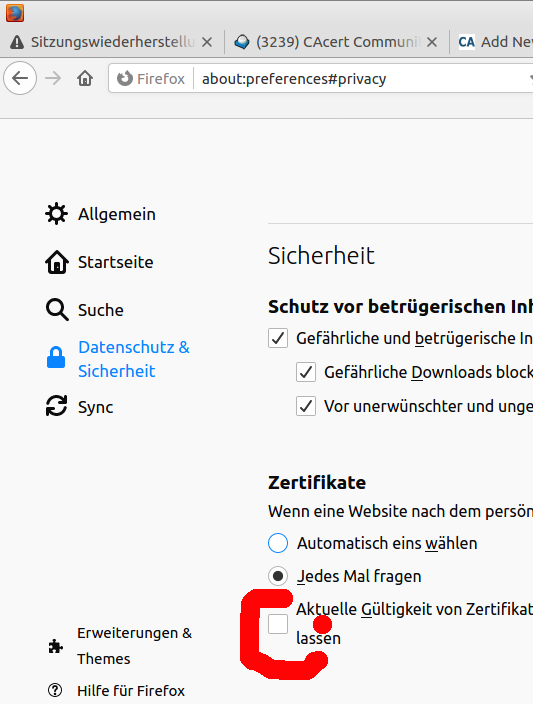DEUTSCH WEITER UNTEN / FRANCAIS CI-DESSOUS

The word “Advent” is Latin and means “arrival”. In the church, Advent is the time of waiting for Christmas. For four weeks. In darkness. But then it gets light. The Christmas season from Christmas Eve to Epiphany: candles, fine food, angels singing, beautiful music, presents.
If we transfer this to CAcert, CAcert is also in a kind of Advent season: it has been going on for a while and will continue for a while longer. It is dark, but we hope for something better. “The people in darkness await the coming of the light.” CAcert activists have been setting a new course for various things over the past few years. We see light at the end of the tunnel. But again, workers are few and work is many.
Therefore, on this fourth Sunday of Advent, we are launching an appeal to all: Come and join us. Join in. Help somewhere. Half an hour here or an hour there. Can we do this once a week? You and I, all of us together, will get there faster! At the moment there are two important jobs. They are far too big for one person, but we can manage them if we share the workload:
- rewrite the PHP code (a big start is already done). After that, a lot of important smaller work can be done by others, which has already been prepared.
- a new possibility to create certificates on your own computer with a few mouse clicks, like in the browser before Mozilla and Google removed the command from the browsers. Here, too, a small group is actively researching and evaluating the first possibilities. Subsequently, we have two projects in the pipeline to roll out, with which CAcert can go mainstream and also sustainably improve the financial situation.
Maybe your country or region is in official hibernation at the moment? Or are you quarantined for a fortnight? Then use the time; every contribution helps, every line of code, every support!
This is your next step:
- Join the developers: https://lists.cacert.org/wws/info/cacert-devel and get in touch with our volunteers, ask questions, get actively involved, create code, proove of concepts, …
Still hesitating? Then look here: https://bugs.cacert.org Grab a small bug and present your solution. You have 1001 possibilities.
FRANCAIS
Le mot “Avent” est en latin et signifie “arrivée”. Dans l’église, Avent est la saison de l’attente de Noël. Pendant quatre semaines. Dans l’obscurité. Mais ensuite, il y a de la lumière. La saison de Noël, de la veille de Noël à l’Épiphanie: bougies, nourriture fine, chants d’anges, belle musique, cadeaux.
Si on applique cela à CAcert, CAcert est aussi dans une sorte de saison de l’Avent: cela dure depuis un certain temps et cela va durer encore un certain temps. Il fait sombre, mais nous espérons quelque chose de mieux. “Les gens dans les ténèbres attendent la venue de la lumière.” Les militants de CAcert ont réinitialisé divers commutateurs au cours des dernières années. Nous voyons de la lumière au bout du tunnel. Mais là encore, les travailleurs sont peu nombreux et le travail est nombreux.
C’est pourquoi, en ce quatrième dimanche de l’Avent, nous lançons un appel à tous: venez nous rejoindre. Rejoignez-nous. Aider quelque part. Une demi-heure ici ou une heure là. Pouvons-nous le faire une fois par semaine? Vous et moi, tous ensemble, nous y arriverons plus vite! Pour l’instant, il y a deux emplois importants. Ils sont trop grands pour une seule personne, mais nous pouvons les faire ensemble:
- réécrire le code PHP (un grand départ est déjà fait). Après cela, nous pouvons faire beaucoup de petits travaux importants, qui sont déjà préparés.
- une nouvelle possibilité de créer à nouveau des certificats sur votre propre ordinateur en quelques clics de souris, comme dans le navigateur avant que Mozilla et Google ne suppriment la commande des navigateurs. Là encore, un petit groupe recherche et évalue activement les premières possibilités. Par la suite, nous avons deux projets en cours de réalisation, qui permettront à CAcert de se généraliser et d’améliorer la situation financière de manière durable.
Peut-être votre pays ou votre région est-il en hibernation officielle en ce moment? Ou vous êtes sous quarantaine pour deux semaines? Alors profitez du temps; chaque contribution aide, chaque ligne de code, chaque soutien!
C’est votre prochaine étape:
- inscrivez-vous auprès des développeurs: https://lists.cacert.org/wws/info/cacert-devel et entrez en contact avec nos volontaires, posez des questions, participez activement, créez du code, vérifiez les concepts, …
Vous hésitez encore? Alors regardez ici: https://bugs.cacert.org Capturez un petit bug et présentez votre solution. Vous avez 1001 possibilités.
DEUTSCH
Das Wort “Advent” ist lateinisch und bedeutet “Ankunft”. Die Adventszeit ist in der Kirche die Wartezeit, in der man auf Weihnachten warten. Vier Wochen lang. In der Dunkelheit. Doch dann wird es hell. Die Weihnachtszeit von Heilig Abend bis Dreikönigstag: Kerzen, feines Essen, Engelsgesang, schöne Musik, Geschenke.
Wenn wir dies auf CAcert übertragen, befindet sich CAcert auch in einer Art Adventszeit: Sie dauert schon eine Weile und wird noch etwas weiter andauern. Es ist dunkel, aber wir hoffen auf etwas besseres. “Das Volk im Dunkeln wartet auf die Ankunft des Lichts.” Die Aktiven von CAcert haben in den vergangenen Jahren verschiedene Weichen neu gestellt. Wir sehen Licht am Ende des Tunnels. Aber auch hier gilt: Der Arbeiter sind wenige und Arbeit viel.
Deshalb lancieren wir am heutigen vierten Adventssonntag einenn Appell an alle: Komm zu uns. Mach mit. Hilf irgendwo. Eine halbe Stunde hier oder eine Stunde dort. Geht das einmal wöchentlich? Du und ich, wir alle zusammen kommen gemeinsam schneller ans Ziel! Im Moment stehen zwei wichtige Arbeiten an. Für einen sind die viel zu gross, aber aufgeteilt auf mehrere Schultern können wir die stemmen:
- Den PHP Code neu schreiben (ein grosser Anfang ist bereits erledigt). Anchliessend können ganz viele wichtige kleinere Arbeiten ausgeführt werden, die bereits vorbereitet sind.
- Eine neue Möglichkeit, dass man Zertifikate wieder mit wenigen Mausklicks auf dem eigenen Computer erstellen kann, wie weiland im Browser, bevor Mozilla und Google des -Befehl aus den Browsern entfernt haben. Auch hier ist eine kleine Gruppe aktiv am Forschen und evaluiert erste Möglichkeiten. Anschliessend haben wir zzwei Projekte in der Pipeline zum Ausrollen, mit denen CAcert in die Fläche geht und auch die finanzielle Situation nachhaltig verbessern kann.
Vielleicht ist dein Land oder deine Region im Moment gerade im amtlich verordneten Winterschlaf? Oder du stehst für vierzehn Tage unter Quarantäne? Dann nutze die Zeit; jeder Beitrag hilft, jede Codezeile, jede Unterstützung!
Das ist dein nächster Schritt:
- melde dich bei den Entwicklern an: https://lists.cacert.org/wws/info/cacert-devel und tritt mit unseren Freiwilligen in Kontakt, Stelle fragen, beteilige dich aktiv, erstelle Code, proove of concepts, …
Zögerst du noch? Dann schau hier: https://bugs.cacert.org Schnapp dir einen kleinen Bug und präsentiere deine Lösung. Du hast 1001 Möglichkeiten.







 It is not only the computers of the future that pose a threat to security, it is also the legacy of the past. Over the past two or three decades, it has become clear time and again that the majority of Internet users are struggling to replace insecure protection mechanisms. It usually takes more than ten years to introduce an improved security protocol on a large scale. If the fear of quantum computers helps to overcome this inertia, i.e. if the efforts of post-quantum cryptography are conducive to “crypto-agility”, then these novel computers have proven to be useful – even if they will never exist.
It is not only the computers of the future that pose a threat to security, it is also the legacy of the past. Over the past two or three decades, it has become clear time and again that the majority of Internet users are struggling to replace insecure protection mechanisms. It usually takes more than ten years to introduce an improved security protocol on a large scale. If the fear of quantum computers helps to overcome this inertia, i.e. if the efforts of post-quantum cryptography are conducive to “crypto-agility”, then these novel computers have proven to be useful – even if they will never exist. The grid-based cryptographic methods are considered to be very secure. This assessment is based on theoretical considerations and mathematical calculations. At the Institute for Microelectronics and Embedded Systems at the University of Applied Sciences of Eastern Switzerland, the focus is less on mathematical theories than on the way in which these theories are technically implemented. On the one hand, the researchers in Rapperswil (on the Lake Zurich, Switzerland) want to advance the development of fast computer chips for post-quantum cryptography. On the other hand, they also want to analyse the security of such systems. “Some algorithms that look good on paper,” explains Dorian Amiet, “prove vulnerable in practice to so-called side-channel attacks. Amiet has been working as a project member in Rapperswil for about two years on programming aspects of post-quantum cryptography.
The grid-based cryptographic methods are considered to be very secure. This assessment is based on theoretical considerations and mathematical calculations. At the Institute for Microelectronics and Embedded Systems at the University of Applied Sciences of Eastern Switzerland, the focus is less on mathematical theories than on the way in which these theories are technically implemented. On the one hand, the researchers in Rapperswil (on the Lake Zurich, Switzerland) want to advance the development of fast computer chips for post-quantum cryptography. On the other hand, they also want to analyse the security of such systems. “Some algorithms that look good on paper,” explains Dorian Amiet, “prove vulnerable in practice to so-called side-channel attacks. Amiet has been working as a project member in Rapperswil for about two years on programming aspects of post-quantum cryptography.